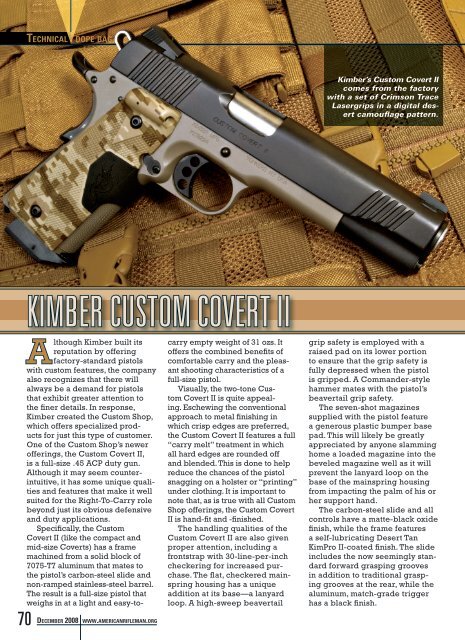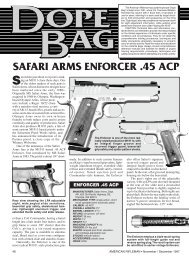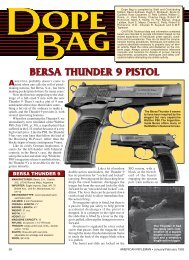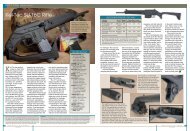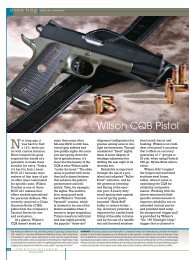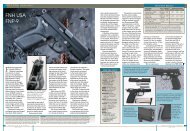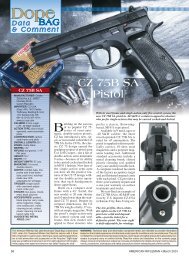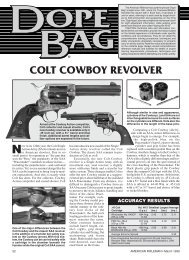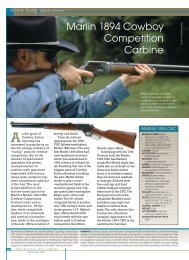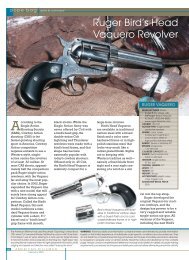easy-tocarry
Download AR Dope Bag Dec. 2008: Kimber Custom Covert II ...
Download AR Dope Bag Dec. 2008: Kimber Custom Covert II ...
- No tags were found...
Create successful ePaper yourself
Turn your PDF publications into a flip-book with our unique Google optimized e-Paper software.
Te c h n i c a l d o p e b a g<br />
Kimber’s Custom Covert II<br />
comes from the factory<br />
with a set of Crimson Trace<br />
Lasergrips in a digital desert<br />
camouflage pattern.<br />
KIMBER Custom Covert II<br />
70<br />
December 2008 w w w .a m e r i c a n r i f l e m a n.o r g<br />
Although Kimber built its<br />
reputation by offering<br />
factory-standard pistols<br />
with custom features, the company<br />
also recognizes that there will<br />
always be a demand for pistols<br />
that exhibit greater attention to<br />
the finer details. In response,<br />
Kimber created the Custom Shop,<br />
which offers specialized products<br />
for just this type of customer.<br />
One of the Custom Shop’s newer<br />
offerings, the Custom Covert II,<br />
is a full-size .45 ACP duty gun.<br />
Although it may seem counterintuitive,<br />
it has some unique qualities<br />
and features that make it well<br />
suited for the Right-To-Carry role<br />
beyond just its obvious defensive<br />
and duty applications.<br />
Specifically, the Custom<br />
Covert II (like the compact and<br />
mid-size Coverts) has a frame<br />
machined from a solid block of<br />
7075-T7 aluminum that mates to<br />
the pistol’s carbon-steel slide and<br />
non-ramped stainless-steel barrel.<br />
The result is a full-size pistol that<br />
weighs in at a light and <strong>easy</strong>-<strong>tocarry</strong><br />
empty weight of 31 ozs. It<br />
offers the combined benefits of<br />
comfortable carry and the pleasant<br />
shooting characteristics of a<br />
full-size pistol.<br />
Visually, the two-tone Custom<br />
Covert II is quite appealing.<br />
Eschewing the conventional<br />
approach to metal finishing in<br />
which crisp edges are preferred,<br />
the Custom Covert II features a full<br />
“carry melt” treatment in which<br />
all hard edges are rounded off<br />
and blended. This is done to help<br />
reduce the chances of the pistol<br />
snagging on a holster or “printing”<br />
under clothing. It is important to<br />
note that, as is true with all Custom<br />
Shop offerings, the Custom Covert<br />
II is hand-fit and -finished.<br />
The handling qualities of the<br />
Custom Covert II are also given<br />
proper attention, including a<br />
frontstrap with 30-line-per-inch<br />
checkering for increased purchase.<br />
The flat, checkered mainspring<br />
housing has a unique<br />
addition at its base—a lanyard<br />
loop. A high-sweep beavertail<br />
grip safety is employed with a<br />
raised pad on its lower portion<br />
to ensure that the grip safety is<br />
fully depressed when the pistol<br />
is gripped. A Commander-style<br />
hammer mates with the pistol’s<br />
beavertail grip safety.<br />
The seven-shot magazines<br />
supplied with the pistol feature<br />
a generous plastic bumper base<br />
pad. This will likely be greatly<br />
appreciated by anyone slamming<br />
home a loaded magazine into the<br />
beveled magazine well as it will<br />
prevent the lanyard loop on the<br />
base of the mainspring housing<br />
from impacting the palm of his or<br />
her support hand.<br />
The carbon-steel slide and all<br />
controls have a matte-black oxide<br />
finish, while the frame features<br />
a self-lubricating Desert Tan<br />
KimPro II-coated finish. The slide<br />
includes the now seemingly standard<br />
forward grasping grooves<br />
in addition to traditional grasping<br />
grooves at the rear, while the<br />
aluminum, match-grade trigger<br />
has a black finish.
SHOOTING RESULTS (25 YDS.)<br />
.45 ACP<br />
Ca l i b e r<br />
Fe d e r a l PD<br />
No. C45C<br />
185-g r. JHP<br />
Re m i n g t o n<br />
No. GS45APB<br />
230-g r. JHP<br />
Wi n c h e s t e r<br />
No. Q4170<br />
230-g r. FMJ<br />
Ve l. @ 15'<br />
(f.p.s.)<br />
966 Av g.<br />
13 Sd<br />
872 Av g.<br />
18 Sd<br />
776 Av g.<br />
14 Sd<br />
En e r g y<br />
(f t.-l b s.)<br />
Gr o u p Si z e In In c h e s<br />
Sm a l l e s t La r g e s t Av e r a g e<br />
383 1.23 3.97 2.67<br />
388 0.98 1.73 1.45<br />
308 2.21 4.03 2.93<br />
Av e r a g e Ex t r e m e Sp r e a d 2.35<br />
Me a s u r e d av e r a g e v e l o c i t y f o r 10 r o u n d s f r o m a 5" b a r r e l. Ra n g e t e m p e r at u r e:<br />
77° F. Humidity: 45%. Ac c u r a c y f o r f i v e, c o n s e c u t i v e f i v e-s h o t g r o u p s at 25 y d s.<br />
f r o m a s a n d b a g. Ab b r e v i at i o n s: FMJ (full m e t a l j a c k e t), JHP (j a c k e t e d h o l l o w<br />
p o i n t), PD (Pe r s o n a l De f e n s e), Sd (Sta n d a r d d e v i at i o n).<br />
KIMBER CUSTOM COVERT II<br />
Ma n u fa c t u r e r: Ki m b e r (De p t. AR),<br />
1 La w t o n St r e e t, Yo n k e r s, NY<br />
10705; (800) 880-2418;<br />
w w w .k i m b e r a m e r i c a.c o m<br />
Ca l i b e r: .45 ACP<br />
Ac t i o n Ty p e: r e c o i l-o p e r at e d,<br />
c e n t e r-f i r e s e m i-a u t o m at i c p i s t o l<br />
Fr a m e : 7075-T7 a l u m i n u m<br />
Ba r r e l: 5"<br />
Ri f l i n g: s i x g r o o v e s, 1:16" LH t w is t<br />
Ma g a z i n e: s e v e n-r o u n d-c a pa c i ty,<br />
d e ta c h a b l e b o x<br />
Si g h t s: three-d o t tritium,<br />
d r i f t-a d j u s ta b l e f o r w i nd a g e;<br />
Cr i ms o n Tr a c e La s e r g r i p<br />
Tr i g g e r Pu l l: 4 l b s.<br />
Ov e r a l l Le n g t h: 8¾"<br />
Wi d t h: 1¼"<br />
He i g h t: 5¾"<br />
We i g h t: 31 o z s.<br />
Ac c e s s o r i e s: p l a s t i c c a s e, m a n u a l<br />
Su g g e s t e d Re ta i l Pr i c e: $1,500<br />
The Custom Covert II features a full<br />
“carry melt” treatment (far l.) in<br />
which all hard edges are rounded.<br />
It also has a non-ambidextrous,<br />
low-profile manual safety as well as<br />
a beavertail grip safety (l.).<br />
The Custom Covert II also has<br />
some design features that bring it<br />
more in line with a traditionalist’s<br />
approach to the M1911, including<br />
a traditional recoil spring assembly<br />
instead of a full-length guide<br />
rod. As with all Kimber’s M1911s, it<br />
employs an internal extractor.<br />
The gun’s non-ambidextrous<br />
low-profile thumb safety, in concert<br />
with the grip safety, offers no<br />
surprises to users familiar with the<br />
M1911’s operation. Internally, it<br />
employs Kimber’s Series II firingpin<br />
block system, which is an<br />
updated Swartz-type safety actuated<br />
by depressing the grip safety.<br />
Sighting and aiming is where<br />
the Custom Covert II really shines.<br />
Topping off the slide is a set of<br />
what Kimber terms “Tactical<br />
Wedge Tritium night sights”—a<br />
three-dot sighting system with a<br />
drift-adjustable rear unit. In addition,<br />
the pistol has Crimson Trace<br />
Lasergrips embossed with the<br />
Kimber logo. Complementing the<br />
tan frame of the pistol, the Lasergrips<br />
have an exclusive digital<br />
desert camouflage pattern on the<br />
bulk of their surface area with a<br />
smaller portion of a wraparound<br />
panel in black.<br />
This wraparound section,<br />
located at the upper portion of<br />
the frontstrap and just below the<br />
trigger guard, features the unit’s<br />
activation switch that is engaged<br />
by simply squeezing in with the firing<br />
hand’s support fingers. A master<br />
on/off switch is on the lower<br />
rear section of the left grip panel.<br />
The actual laser unit is in a raised<br />
housing at the upper portion of the<br />
right grip panel.<br />
For accuracy testing, we fired the<br />
pistol with three types of ammunition,<br />
ranging from basic “hardball”<br />
full-metal jacket loadings to highperformance<br />
jacketed hollow-point<br />
ammunition. The Custom Covert II<br />
experienced three failure-to-feed<br />
malfunctions in the first 50 rounds<br />
of more than 400 rounds of test<br />
ammunition fired. However, there<br />
were no malfunctions for the rest of<br />
the testing process. It would seem<br />
reasonable to attribute the initial<br />
malfunctions to the tightly fitted<br />
nature of this custom pistol and that<br />
it “broke in” soon thereafter.<br />
Accuracy was quite good, no<br />
doubt due to its match-grade<br />
barrel and bushing system. The<br />
pistol showed a preference for<br />
the Remington Golden Saber<br />
230-gr. ammunition in particular.<br />
Despite the lightweight frame,<br />
recoil was reasonably mild and<br />
manageable. The laser unit was<br />
quite helpful during some fastfire<br />
drills, and the tritium threedot<br />
sights were effective and<br />
<strong>easy</strong> to pick up. We also carried it<br />
in a Milt Sparks Summer Special<br />
II inside-the-waistband holster<br />
(www.miltsparks.com) for several<br />
days. The pistol’s lightweight aluminum<br />
frame was greatly appreciated<br />
and made it quite pleasant<br />
to carry.<br />
Although by no means inexpensive,<br />
the Kimber Custom Covert<br />
II offers an outstanding pistol for<br />
those looking for a full-featured<br />
duty gun or a top-notch concealed<br />
carry pistol.<br />
December 2008<br />
Am e r i c a n Rifleman<br />
71
d o p e b a g<br />
Benjamin Discovery .22 Air Rifle<br />
72<br />
Popular in Europe but relatively<br />
uncommon in the<br />
United States, the precharged-pneumatic<br />
(or PCP) rifle<br />
has been given a boost in this<br />
country through the introduction<br />
of the new Benjamin Discovery.<br />
Pre-charged-pneumatic rifles,<br />
based on a system of operation<br />
that dates back to the 16th century,<br />
offer advantages over other<br />
more-common types of air rifles.<br />
As compared to spring-piston<br />
powered air rifles, which must be<br />
cocked for each shot, PCP rifles<br />
provide a string of shots powered<br />
by a charged air reservoir (either<br />
from a hand pump or a high-pressure<br />
air tank).<br />
There are potential disadvantages<br />
to PCP rifles that have kept<br />
them primarily in the hands of<br />
motivated enthusiasts and out of<br />
those of beginners and younger<br />
shooters. First, they are significantly<br />
more expensive than<br />
comparable spring-powered air<br />
rifles. In addition to cost, PCP air<br />
rifles can require the strength of an<br />
adult to fully charge them through<br />
the use of a hand pump. The other<br />
December 2008 w w w .a m e r i c a n r i f l e m a n.o r g<br />
option is using a high-pressure<br />
air tank, which can be difficult to<br />
locate or expensive to use.<br />
The new Benjamin Discovery<br />
PCP pellet rifle, however, aims to<br />
change that. Available in either<br />
.177 or .22 caliber and made here<br />
in the United States by Crosman,<br />
the bolt-action single-shot Discovery<br />
sells for roughly one-third<br />
less than a comparable European<br />
PCP rifle. But the reasonable cost<br />
is not the only reason beginners<br />
and young shooters may want to<br />
consider the Discovery.<br />
Whereas most conventional PCP<br />
rifles require 3,000 p.s.i. of pressure<br />
to perform effectively, the<br />
Benjamin Discovery requires only<br />
2,000 p.s.i. to power a .177-cal.<br />
pellet up to a claimed 1000 f.p.s.<br />
and a .22-cal. pellet up to 900 f.p.s.<br />
The result is that the Discovery can<br />
be charged through the use of the<br />
optional hand pump. Roughly 70<br />
to 100 manageable strokes yield<br />
25 to 35 powerful shots before<br />
recharging is required. In addition,<br />
high-pressure air tanks can also be<br />
used with the Discovery.<br />
The Discovery offers another<br />
innovative take on the PCP design,<br />
namely something referred to as<br />
“dual fuel” capability. In addition<br />
to being powered by compressed<br />
air through the use of either a hand<br />
pump or a high-pressure air tank,<br />
the Benjamin Discovery can also<br />
be powered with CO 2 . Employing<br />
an optional adapter, the Discovery<br />
can be powered up from a standard<br />
paintball tank, although only up<br />
to 900 p.s.i. While velocities are<br />
reduced, it can shoot for roughly<br />
100 shots before needing a refill.<br />
This is due to the unique nature of<br />
CO 2 and that it continues to expand<br />
as it turns from a liquid to a gas.<br />
Compressed air and CO 2 should<br />
not be combined, and a degasser<br />
tool to empty the Discovery’s reservoir<br />
is also available.<br />
The rifle can be purchased by<br />
itself, but our sample Discovery<br />
was packed as a kit with a hand<br />
pump and was chambered for<br />
.22-cal. pellets. While affordable<br />
by PCP rifle standards, the $379<br />
price for this kit is still a substantial<br />
amount of money for many<br />
purchasers, so a certain level of<br />
quality is to be expected in this
SHOOTING RESULTS (50 YDS.)<br />
.22-Ca l.<br />
Pe l l e t<br />
Be e m a n Ko d i a k<br />
21.1-g r. RN<br />
Cr o s m a n BHP22<br />
14.3-g r.<br />
Cr o s m a n<br />
14.3-g r. Do m e d FTP<br />
Ve l. @ 10'<br />
(f.p.s.)<br />
716 Av g.<br />
32 Sd<br />
843 Av g.<br />
26 Sd<br />
831 Av g.<br />
19 Sd<br />
En e r g y<br />
(f t.-l b s.)<br />
Gr o u p Si z e In In c h e s<br />
Sm a l l e s t La r g e s t Av e r a g e<br />
24 1.23 1.78 1.48<br />
23 0.93 1.49 1.08<br />
22 1.22 1.66 1.39<br />
Av e r a g e Ex t r e m e Sp r e a d 1.32<br />
Me a s u r e d av e r a g e v e l o c i t y f o r 10 r o u n d s f r o m a 24" b a r r e l. Ra n g e t e m p e r at u r e:<br />
74° F. Humidity: 55%. Ac c u r a c y f o r f i v e c o n s e c u t i v e, f i v e-s h o t g r o u p s at 50 y d s.<br />
f r o m a s a n d b a g r e s t. Ab b r e v i at i o n s: BHP (Be n j a m i n h o l l o w p o i n t), FTP (field ta r g e t<br />
p e l l e t), RN (r o u n d n o s e), Sd (s ta n d a r d d e v i at i o n).<br />
BENJAMIN DISCOVERY .22<br />
Ma n u fa c t u r e r: Cr o s m a n Co r p.<br />
Di s t r i b u t o r: Py r a m y d Air (De p t. AR),<br />
26800 Fa r g o Av e., Un i t No. L,<br />
Be d f o r d He i g h t s, OH 44146;<br />
(888) 262-4867;<br />
w w w .p y r a m y d a i r.c o m<br />
Ca l i b e r: .177, .22 (t e s t e d)<br />
Ac t i o n Ty p e: p r e-c h a r g e d p n e u m at i c,<br />
b o lt-a c t i o n s i n gl e-s h o t a i r rifle<br />
Re c e i v e r: b l u e d s t e e l<br />
Ba r r e l: 24", b l u e<br />
Ri f l i n g: 10-g r o o v e, 1:16" RH t w is t<br />
Si g h t s: Williams Fi r eSi gh t s t h r e e-d o t<br />
f i b e r-o p t i c, fully a d j u s ta b l e<br />
Tr i g g e r Pu l l: s i n gl e s ta g e, 4 lbs., 8 o z s.<br />
St o c k: Am e r i c a n wa l n u t:<br />
l e n g t h o f p u l l 14": d r o p at h e e l, 1";<br />
d r o p at c o m b , 1½"<br />
Ov e r a l l Le n g t h: 39"<br />
We i g h t: 5 l b s., 2 o z s.<br />
Ac c e s s o r i e s: o w n e r’s m a n u a l, p u m p<br />
Pr i c e: $379 (a s t e s t e d),<br />
$239 f o r rifle o n ly<br />
Just forward of the trigger-guard<br />
on the stock’s bottom is a pressure<br />
gauge (far l.) for the Discovery’s air<br />
reservoir marked for both compressed<br />
air and CO 2 use. The reservoir<br />
is filled through a nipple that is<br />
located just below the barrel’s muzzle<br />
(l.) and is protected by a plastic cap.<br />
product—and the wood-and-steel<br />
Discovery did not disappoint.<br />
The rifle is extremely light and<br />
handy, weighing in at 5 lbs., 2 ozs. It<br />
sports a one-piece stock of American<br />
walnut with a satin finish and<br />
no checkering. The wood-to-metal<br />
fit overall was good, with only a few<br />
uneven gaps around the trigger<br />
guard. Inlaid into the bottom of the<br />
stock just forward of the trigger<br />
guard is a pressure gauge for the<br />
air reservoir, with markings for both<br />
compressed air and CO 2 usage.<br />
The steel barrel and breech<br />
are of carbon steel with an evenly<br />
applied and attractive blue finish<br />
that is matched on the highpressure<br />
air reservoir under the<br />
barrel. While the bolt is stainless<br />
steel, the trigger guard and nonadjustable<br />
trigger are both of<br />
plastic. A simple crossbolt safety<br />
is located in the rear portion of<br />
the trigger guard.<br />
Topping off the barrel is a set<br />
of Williams FireSights that feature<br />
fiber-optic inserts for greater<br />
visibility. The rear sight sports a<br />
U-shaped red insert while the front<br />
sight has a green rod insert, resulting<br />
in a high-visibility three-dot<br />
sighting system. The rear sight unit<br />
is fully adjustable. In addition, the<br />
receiver has an 11 mm scope rail.<br />
To operate the rifle, ensure that<br />
it is on safe and the bolt-action<br />
is uncocked. Remove the plastic<br />
cap at the end of the air reservoir<br />
under the barrel to expose<br />
the fill nipple, and then attach<br />
the included hand pump’s hose.<br />
After ensuring the bleed valve on<br />
the pump is fully closed, use the<br />
pump to pressurize the reservoir<br />
to 2,000 p.s.i. If the Discovery is<br />
The American Rifleman has used the phrase “Dope Bag” since at least 1921, when Col. Townsend<br />
Whelen first titled his column with it. Even then, it had been in use for years, referring to a sack used<br />
by target shooters to hold ammunition and accessories on the firing line. “Sight dope” also was a<br />
traditional marksman’s term for sight-adjustment information, while judging wind speed and direction<br />
was called “doping the wind.”<br />
WARNING: Technical data and information contained herein are intended to provide information<br />
based on the limited experience of individuals under specific conditions and circumstances. They do<br />
not detail the comprehensive training procedures, techniques and safety precautions absolutely necessary<br />
to properly carry on similar activity. Read the notice and disclaimer on the contents page. Always<br />
consult comprehensive reference manuals and bulletins for details of proper training requirements,<br />
procedures, techniques and safety precautions before attempting any similar activity.<br />
accidentally overfilled past 2,000<br />
p.s.i., the shooter should dry fire<br />
the rifle in a safe direction until<br />
pressure drops to 2,000 p.s.i.<br />
To load, the bolt is opened and<br />
retracted fully until two clicks are<br />
heard, and then a pellet placed<br />
nose first into the breech. The bolt<br />
can be then closed gently and<br />
locked down.<br />
For testing, we tried the Discovery<br />
with a selection of .22-cal.<br />
pellets from Crosman and Beeman.<br />
It proved <strong>easy</strong> to pump up to<br />
proper pressure with the included<br />
hand pump, and it performed well<br />
with no malfunctions. To wring out<br />
the best possible accuracy, we<br />
kept shot strings to 25 total before<br />
recharging the air reservoir. The<br />
FireSights provided a good sight<br />
picture that allowed us to get quite<br />
good groups at 50 yds.<br />
The Benjamin Discovery 22<br />
appears to have it all—ease of<br />
use, reasonable cost and high<br />
quality. For beginners who want to<br />
get into PCP rifles or for shooters<br />
who simply appreciate a quality<br />
product, the Benjamin Discovery<br />
is worth a look.<br />
December 2008 Am e r i c a n Rifleman<br />
73


